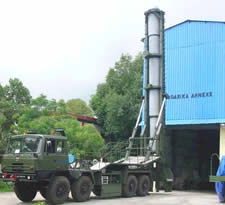  |
| Mystery missile: widely reported as a future sea-launched ballistic missile, is the Shourya launch in November 2008 (right) a land-based mobile missile (left), a silo-based missile, or a hybrid? Images: DRDO |
.
By Hans M. Kristensen
A decade after India officially crossed the nuclear threshold and announced its intention to develop a Triad of nuclear forces based on land-, air-, and sea-based weapon systems, its operational force primarily consists of gravity bombs delivered by fighter jets. Short of the short-range Prithvi, longer-range Agni ballistic missiles have been hampered by technical problems limiting their full operational status [Update Feb. 2, 2009: “Defense sources” quoted by Times of India appear to confirm that the Agni missiles are not yet fully operational]. A true sea-based deterrent capability is still many years away.
Despite these constraints, indications are that India’s nuclear capabilities may evolve significantly in the next decade as Agni II and Agni III become operational, the long-delayed ATV nuclear-powered ballistic missile submarine is delivered, and warhead production continues for these and other new systems.
Our latest estimate of India’s nuclear forces is available from the Bulletin of the Atomic Scientists.
The FY2026 National Defense Authorization Act (NDAA) paints a picture of a Congress that is working to both protect and accelerate nuclear modernization programs while simultaneously lacking trust in the Pentagon and the Department of Energy to execute them.
While advanced Chinese language proficiency and cultural familiarity remain irreplaceable skills, they are neither necessary nor sufficient for successful open-source analysis on China’s nuclear forces.
Satellite imagery has long served as a tool for observing on-the-ground activity worldwide, and offers especially valuable insights into the operation, development, and physical features related to nuclear technology.
This report outlines a framework relying on “Cooperative Technical Means” for effective arms control verification based on remote sensing, avoiding on-site inspections but maintaining a level of transparency that allows for immediate detection of changes in nuclear posture or a significant build-up above agreed limits.